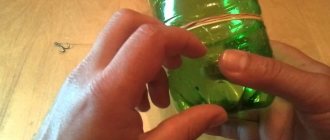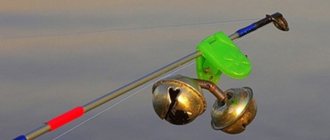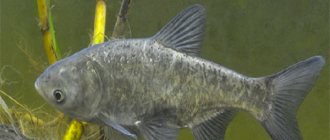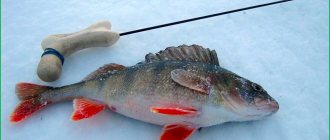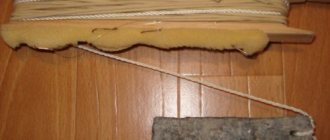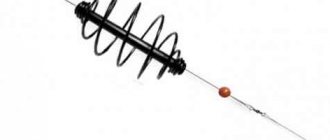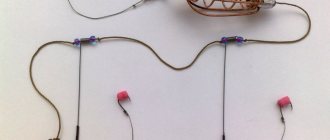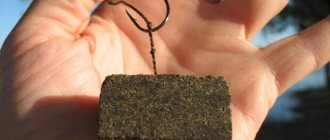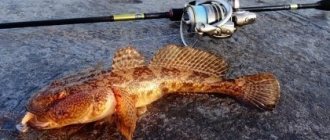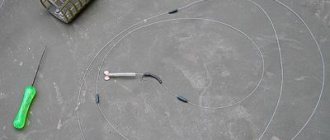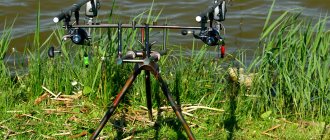Catching burbot in the fall with a bait is one of the best ways to hunt for this secretive and mysterious fish. The simplicity of preparing a fishing kit and a simple fishing strategy allows you to quickly find the places of movement of a predator and add significant results to your trophy list. In addition, the autumn season is a favorable time when the burbot bite increases every day as the water cools, turning into periods of feeding.
For an angler who has never practiced catching freshwater cod, the bait can become the tool that will allow him to experience the taste of burbot hunting. Indeed, for success in catching a predator, knowledge of its habits plays a primary role, on the basis of which you can determine the paths of movement of the fish and figure out what time is best to fish. We will tell you about all the intricacies of catching burbot with a hook in the article presented to the reader, with the hope that having mastered the information, the fisherman will be able to understand the design of this effective gear without much difficulty and learn about the principles of burbot behavior and their food preferences, and this will ultimately help to get seemingly elusive fish to the trophy list.
Tackle design
The design of the bait for burbot is extremely simple. The gear includes elements familiar to every angler. The tackle does not require special delicacy or fine tuning . Burbots going out to hunt, without any regard for caution, collect any edible animal material that is located on the trajectory of the fish, including a hook equipped with bait. To assemble the hook, you will need a nylon main line with a diameter of up to 0.4 mm in a cut of no more than 30 meters, which is stored on a wooden reel made of plywood up to 20 mm thick with end slots 3 cm deep, made in the shape of a dovetail.
The casting of the equipment and its anchoring at the bottom is aided by a sliding weight, selected by its mass to suit the fishing conditions, namely the forces of the current. A leash made of braided fishing line, 12–15 mm thick and no more than 20 cm long, is mounted behind the sliding load. The leash is equipped with a hook, selected in shape and size based on the size and type of bait. To make it easier to control the bite, most fishermen equip their baits with sound alarms in the form of bells.
Installation of a snack
Snack tackles are also easy to install. The main fishing line in the form of rings is laid on a gentle bank, which is usually a sand spit, washed up and smoothed by the current, and opposite it, as a rule, is located on the opposite side a high bank with a cliff. A deep pool with driftwood at the bottom swirls beneath him.
the main fishing line lying in rings on the sand, only now in the opposite direction. This way the line will go into the water without tangles or loops after casting.
The reel with the remaining main line is simply stuck into the sand. It is for this reason that it is advisable to use a reel, not a purchased plastic one, which is not enough for one fishing trip, but a homemade one, made from a solid board or durable plastic.
Now all that remains is to make the cast. For this purpose, the sinker is swung in a pendulum manner on the fishing line and then sent into the water with a strong push, carefully monitoring so that the hooks do not catch on clothing and the body. After casting, the line must be secured in the split tip of a willow rod and a ringing bell must be hung on the line with a simple tightening loop. You can attach a bell from the feeder to the flexible tip of the rod.
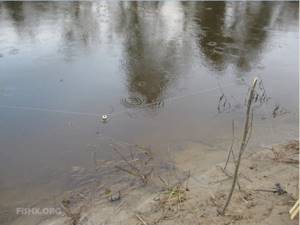
After all these operations, all that remains is to wait by the crackling hot fire for the bell to ring, which means for the bite of the night predator. To comfortably remove prey and attach worms, you need a large hand-held flashlight that can be placed at the trench, and a headlamp is a must. It will shine exactly in the direction the angler is looking.
Share with your friends!
Requirements for hooks and line
A fishing line up to 0.4 mm thick will ensure reliable fishing, holding even fish larger than five kilograms when biting.
Important! The rationale for using nylon fishing line for the base lies in its high stretch coefficient, which helps to catch not only large fish, but also to comfortably remove the equipment from the hooks, which are not uncommon during burbot hunting with a hook.
A braided leader is used to minimize rubbing of the rig by a fish that takes the bait. After all, this quiet fish, having swallowed the bait, remains motionless for a long time on the bottom, calmly digesting its food. Having missed the bite signal, the fisherman risks losing his catch, since in a couple of hours the fish will easily grind the nylon monofilament with its small bristly teeth, which are located on its jaws and vomer.
Important! According to its design, a hook with a long shank is selected for burbot fishing.
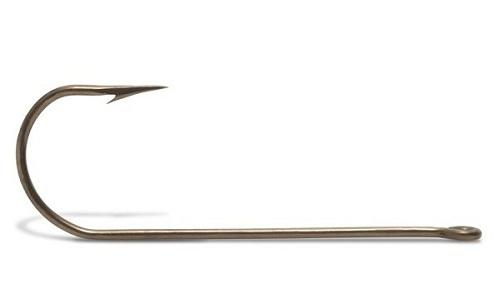
First of all, this configuration allows you to attach bait in a bunch, which is important when fishing by crawling, and also ensure reliable fixation of live bait by mounting it by the lip or under the fin. An important convenience of such an accessory is its removal from the mouth or stomach of a caught fish. Burbots swallow baits deeply, and the elongated forend makes it easier to remove the trophy from the hook and continue fishing without changing the equipment. As a rule, hooks number 6–10 according to the generally accepted classification are suitable for catching predators.
How to make a burbot bait with your own hands
Having become familiar with the principle of operation and design of the tackle, the fisherman prepares the material necessary for the manufacture of the product. To do this, prepare a piece of plywood for the reel, monofilament and braided fishing line according to the diameters indicated in the previous chapter, sliding sinkers or lead for their independent melting, as well as hooks.
Important! Among the auxiliary elements for assembling the hook, damper beads would be useful to prevent the occurrence of defects from the impact of loads on the equipment components and fasteners for attaching leashes to the main fishing line.
Alarms can be purchased at a fishing store, or you can make them yourself by adapting the base of used incandescent lamps to the bells, installing freely moving reeds made of a metal rod in them. The production of a set of hooks will be facilitated by the presence of a tool such as a jigsaw or a small hacksaw for wood and a penknife. As you can see, having this small list of necessary materials and tools in stock, such tackle can be assembled right on the shore of a reservoir in just 15–20 minutes, and believe me, a predator can be caught quite effectively with this simple device.
We make donks for burbot
Fishermen have developed several types of this gear. A detailed manufacturing scheme for the 3 main structures will be discussed in this chapter.
Donka with a hook
For work we will need:
- Long spinning rod with a reel for long casting;
- Reel or plastic bottle for coastal fishing;
- Main forest. Its thickness depends on the size of the fish. Minimum thickness – 0.3 mm;
- Sinker. It is selected taking into account the river flow and casting distance. The tackle should not be washed away by water. The minimum weight of the sinker is 50 g;
- Leash line, maximum thickness – 0.25 mm;
- Hook. Depending on the size of predators and live bait, we recommend using No. 8 – 12 with a thin and long fore-end. It damages the fish less and allows you to quickly remove it from the mouth of the burbot.
We carry out all work in several stages:
- We wind a supply of line onto a reel or reel. Donka is not used at a distance from the shore of more than 50 m;
- If you plan to fish near the shore, you can use a simple plastic bottle for the reel. You can use it to make a summer version of the zherlitsa. To do this, drill a hole in the lid with a thin drill. We set up the line and tie a stopper so that it cannot get out of the hook. We wind the line in the recess on the body of the bottle and prepare the tackle. On the pond, having measured the line, we make a small loop from the fishing line and put it under the wound elastic band for money. After casting, our float will be bottom up. After the bite, the loop will come out from under the rubber band, and the bottle will work as a bite alarm; it will turn over and a neck with a colored cap will be visible from the water. The main thing is not to forget to fix the vent on the shore;
- We tie the sinker to the main fishing line. The load is made to slide, limiting movement with stops;
- At a distance of 400 mm we make a loop or attach a swivel for the leash;
- We tie a figure eight hook. At the end of the leash, 250-300 mm long, we fix a carabiner.
You can make tackle with a feeder for feeder equipment instead of a sinker. This way you can use animal feed and attractants for predators.
With two leashes
Making such a tackle is simple. We use the previous set of materials, only add a second leash with a hook. We attach the first hook with line directly to the sinker, and attach the second, equipped with a carabiner, at a distance from the first, at least 500–600 mm.
The main thing is to remember the basic rule of a fisherman - you cannot knit leashes so that the distance between them is less than 2 lengths of the line segments. Otherwise, the line of leashes or the sinker will constantly get tangled or overlapped.
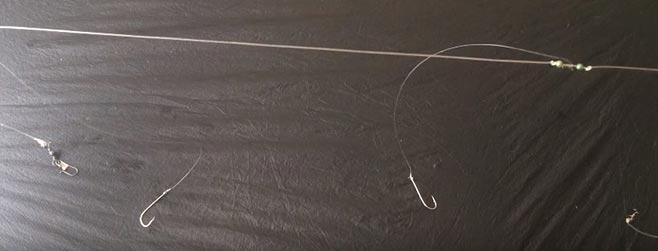
Fishermen consider such equipment to be complex and not affect catchability. There is an increased risk of the line getting tangled and one burbot getting caught on two hooks at the same time. When casting over long distances, such a donkey will get confused even when entering the water.
Conclusion - two leashes increase the area of probable detection of the bait by a predator, but increases the possibility of tangling the equipment.
Important! Using a simple tin can or plastic bottle as a reel will increase your casting range by hand.
Using a noose loop, we fix the line to the body of the can. We wind a supply of cord around it and secure it with an elastic band for money. At the free end we place a swivel with a carabiner, with the help of which we attach a piece of fishing line with a weight and a hook.
Before casting, remove the rubber band and take the can in your left hand (if you are right-handed). Right, we cast. The line will unwind freely from the body of the can and will not cling to grass or ground. After casting, we take out the slack, fix the homemade reel to the peg, tighten the line and set up a bite alarm.
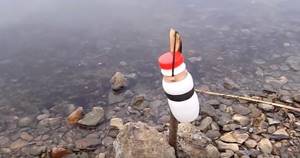
Catching burbot in January on a donk will require minor changes to its design.
Making a winter donka
A hole in the cold will quickly become covered with a crust of ice, the sharp edges of which will damage the forest, and the tackle will be lost. For winter, we use the design of the vents or simply make circles from any material that cover the diameter of the hole in size. When fishing, be sure to take a supply of leashes on carabiners with different numbers of hooks.
Important! Active large burbot is a desired trophy for every fisherman. In winter, the likelihood of being bitten by such predators increases, so a large hook is indispensable for ice fishing.
A large supply of scaffolding is not needed. The length of the cord is 4-5 m greater than the depth. In the circles we make a thin groove for inserting the line. Having baited the bait, after casting it into the hole, we close it with a plastic circle and insert the line into the groove. We reel in the slack and leave the tackle.
They don’t use a bite alarm; you still can’t see it at night. We check the donks every 30–60 minutes, depending on the activity of the burbot. The mugs prevent the water from freezing and it will be easier to remove the burbot from a clean hole.
Baits used
This mysterious representative of cod fish species feeds on purely animal food, in nature eating small items of various fish, leading a pronounced predatory lifestyle. But in practice, fishermen catch burbot not only using live bait, in which ruff is a favorite burbot dish. The fish responds well to hooking with a bunch of dung worm or a crawler, to which maggots and bloodworms are added. You can also use a small frog as bait.
Inert baits include pieces of fish loin, and not necessarily those that live directly in the fished body of water, and even store-bought sea fish is suitable for these purposes. Burbots are caught well using fresh beef liver and chicken giblets. Returning to live bait, in addition to ruffe, predators target gudgeon, spined lance, small roach and perch. When placing live bait in a rig, it is advisable to press it down, which limits the movements of the fry, and the release of fluids from the fish’s body additionally attracts predators to the fishing point.
Suitable weather
You can count on catching burbot in the fall on a bait after a steady drop in air temperature has cooled the water below +12 degrees. It is this indicator that significantly activates the fish, encouraging it to increase feeding.
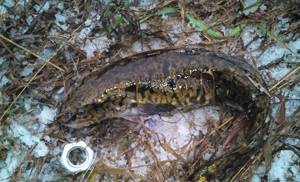
Important! Burbots differ from other fish in behavior that is non-standard, preferring to go hunting in inclement weather during moments of a sharp decrease in pressure, increased wind and precipitation.
Large temperature changes downward are promising for fishing. Clear nights, stabilization of atmospheric pressure and warming, on the contrary, drive the predator into shelter, significantly reducing its feeding activity, and, consequently, productive biting.
Baits and baits for autumn fishing for burbot
Bait for burbot in the fall should be exclusively of animal origin. The predator neglects any plant odors, completely refusing to attack them.
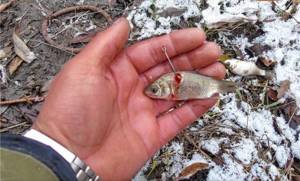
Bait for burbot in the fall should be of exclusively animal origin.
What to use to catch burbot in the fall:
- standard animal bait: bloodworms, large worms, maggots, crawling worms;
- various live baits: gudgeon, ruff, char, perch, roach, loach, perch and other small fish. We recommend baiting the bait by the upper lip or piercing it under the dorsal fin, this will ensure the mobility of the bait. There are other methods of baiting, one of the best options is to pass the hook and line through the mouth and pull it through the gills. If you have a choice, it is better to take the most common fish in the reservoir, usually a gudgeon. The advantage of the ruff is its strong aroma that attracts burbot;
- the easiest bait to obtain is chopped fish or chicken offal;
- Another common bait for catching predators, which is found in all bodies of water, is frogs.
Read more
Why Japanese gear?
The classic method of hunting burbot does not require the use of bait, because the bait itself is quite aromatic and attractive. Many fishermen claim that feeding the area is beneficial. It is better to make bait from clay or earth with the addition of maggots, worms or similar components. We put them in a feeder (if a feeder is used) or roll them into balls and throw them to the fishing spot. A simpler and no less effective option is to throw in minced meat, pieces of fish, chicken offal, etc.
Catching burbot with a hook
The fisherman should know that this type of cod is a purely nocturnal inhabitant and feeds, as well as bites, only in the dark. From this we conclude that burbot fishing is a guaranteed night event. With the onset of dusk, the fish goes out to hunt, constantly moving along the same trajectories, patrolling the bottom of the reservoir for the presence of gape and sleepy prey.
Important! Accurate knowledge of the predator’s route, or among fishermen the so-called burbot trail, is the main key to fishing success.
In unfamiliar waters, based on the structure of the reservoir, and in particular, the composition of the bottom and the presence of various anomalies on it, it is possible with a high probability to determine promising trajectories of burbot movement and, based on these conclusions, conduct successful fishing. We will talk about some of the nuances of choosing places, technical and tactical issues of fishing in more depth in the following sections of the article.
Selecting a location
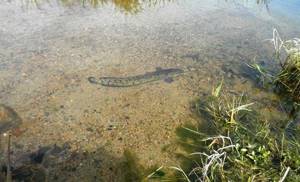
Burbot areas are characterized by hard bottoms with pebble or rocky surfaces. Areas of snags adjacent to such zones and trees that have fallen into the water only increase the angler’s chances of a positive result in the hunt. Fish loves shelters of this kind, looking for secluded and quiet places for a daytime half-asleep state. Depths have little effect on the life activity of the predator; it comfortably lives on half-meter shallows and in holes of a couple of tens of meters. Proximity to coastlines does not have a particular impact on habitats.
Predators are not very timid and get used to constant artificial noise effects caused by the results of human activity. Therefore, coastal fishing at promising points is just as successful as fishing at long distances. Casting for burbot in the fall can be placed on the boundaries of rapids with slowdowns, return flows and gyres of currents. Predators do not miss the opportunity to comb such water formations, in which they can often and without much effort catch small fish tired of fighting the currents.
Casting and installing the hook
Having determined the fishing location, the fisherman prepares the coastline for comfortable casting of gear and unhindered landing of the caught fish. To do this, in the area where the plant is installed, the grass is crushed and the approach to the water is cleared of thickets.
Important! Convenient casting can be hampered by overhanging tree branches and bushes tightly adjacent to the point where the tackle is installed, which must be taken into account before fishing.
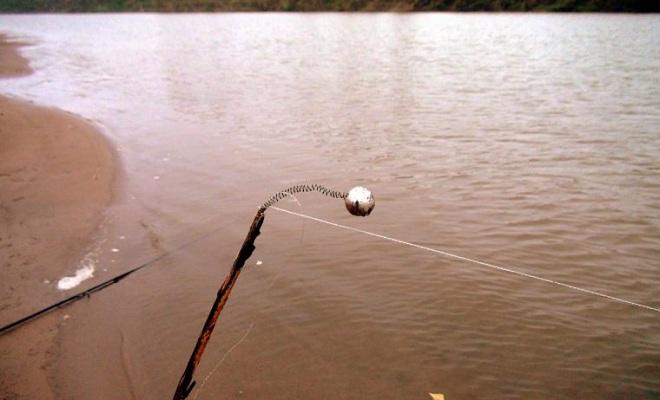
Immediately before casting, a peg is stuck into the shore to secure the fishing line, and the tackle itself, after winding the cord from the reel, is laid nearby in even rings. Having placed the bait on the hook, take the cord in your hand in front of the sliding sinker and with a swing, the force required for the casting distance, feed the rig into the fishing zone. Whether it is a worm or live bait on a hook, they try to make the presentation as soft as possible, throwing the load at a short distance from the surface of the water, which prevents the bait from spontaneously coming off. After casting, the cord is tightened and the alarm is installed, impatiently waiting for it to go off.
Peculiarities of burbot behavior in autumn
Content
The fish prefers reservoirs with extremely clear water, a significant current and the presence of pebbles or stones at the bottom.
Fishing for burbot in the spring is most effective in the following places:
- pits intersecting with cold currents;
- near driftwood;
- next to a scattering of stones;
- with an abundance of protruding roots. If a tree is dry or has been cut down, burbot tends to leave its habitat and swim to another area.

Fishing for burbot in the fall becomes most effective after the middle of the season, when the water temperature drops to 12°C, but as soon as it warms up to 15°C, the activity of the fish decreases greatly. It will not be possible to find a predator in warm water; it descends to the bottom in search of shelter, where it spends the entire warm period of the year.
Some fishermen advise hunting burbot in winter, and this is not unreasonable, because the predator spawns in December and extends into January. It is better to catch it before leaving for the spawning ground, it is important to guess with this period, now there is an active zhor, and accordingly, the most successful fishing begins. During spawning, no bait or attachments are successful for this fish. Only small individuals that have not reached maturity can be hooked.
Hunting for autumn burbot often allows you to get the largest catch of large fish. The predator has a common feature with other inhabitants of reservoirs - an active feeder in the autumn. Catching burbot with donks in the fall is most effective in October; active biting continues until freeze-up.
Burbot is a nocturnal fish that hunts using exclusively its sense of smell and lateral line. Prey practically does not rely on vision, so there is no point in using wobblers of various types, and there is also no need to use dyes.
It is important to take into account that in a number of countries burbot is under state protection and is included in the Red Book, that is, its fishing is prohibited.
Fishing technique
Regardless of the type of bait used, the fishing technique follows the same principle. After casting, bites are expected, in the absence of which the tackle is checked every 1.5-2 hours, inspecting the bait for its presence and suitability. The bite itself may not be distinguished by the persistence of the alarm and may manifest itself only with a single flinch of the bell, after 15 minutes after which the tackle is checked, in most cases receiving an already detected but hidden trophy.
A not very active burbot, having made an effective throw, begins its meal right at the site of the attack, which causes a weak bite signal. When the bell is constantly working, you need to immediately rewind the cord, otherwise the predator will go to its secluded place and hopelessly tangle the tackle. When playing, the fish is not given any slack, forcing it to be pulled to the shore. Thick cords and deep-throated hooks rarely allow an individual to bite and leave the angler without luck.
Peculiarities of catching burbot using bait in September, October and November
Autumn fishing for burbot in its effectiveness varies greatly depending on weather conditions. By the way, the second half of November is considered the high fishing season, not only in the autumn, but also in the entire annual cycle. Let us present to the angler's attention some features of burbot hunting with an eye to the months of the autumn season.
September is an unpromising autumn time, during which the predator is not active and is still in a depressed state from the increased water temperature, spending most of the day in its shelter without feeding or showing any activity. Catching it with hooks can become a rare occurrence in the third ten days of the month when there is a sharp deterioration in the weather and an intense drop in water temperature.
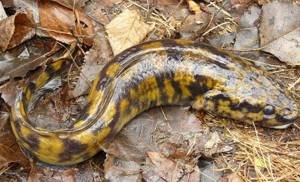
October, from its second half, is considered the beginning of a new burbot hunting season. Water that has cooled to 10–12 degrees activates the predator, and with the onset of the first frost, you can go hunting, placing snookers along the burbot trail at night. Fishing with baits in the form of feeding bleeding livers and pieces of cut fish into voluminous mesh feeders used instead of sinkers into the setting zones is effective.
In November, the predator enters the pre-spawning feeding phase and now its feeding is influenced only by weather factors, the deterioration of which, no matter how paradoxical it may be for the fisherman, improves the biting results. The predator actively takes inert and live baits without additional food, and with bait they catch effectively until the freeze-up. The bite weakens only during the full moon in clear weather, but does not stop completely, bringing only smaller specimens into the catch.
Place and time to catch burbot in autumn
In theory, different places are suitable for fishing, since in cool water the fish actively moves and is able to detect prey everywhere. To increase your chances of catching, we recommend casting the tackle nearby with small fish. The predator pursues the prey and attacks it; at these moments, the burbot can be interested in the prepared bait.
Read more
How to catch bream with a ring from a boat?
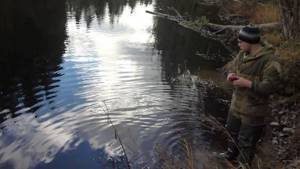
Different places are suitable for fishing
From our own experience, we note that a good catch has been repeatedly obtained on shores with a beach strewn with pebbles or sand, always with a gentle slope and great depth. When fishing with bait, it is often possible to catch fish on washed-out banks with a steep descent.
It is impossible to answer unequivocally how to catch burbot in November, since the catch is unpredictable. If today it is caught near the shore, tomorrow the predator will remain in the middle of the river and will not approach the coastal line at all. The only way to increase your chances of catching burbot is to use three to five baits at a time. It is better to cast all donks at different distances from the shore.
The unpredictability of fish also manifests itself in hunting time; it is often caught on a hook in the morning and evening, although the main fishing time is night. Burbot reacts well to bad weather; the worse it is, the higher the chances of catching fish. The fisherman should immediately seize all potential periods for catching prey, coming for fishing at 17:00 and continuing until 9-10:00. There is no need to keep an eye on the tackle, this is a tedious task; we recommend throwing it in the evening and moving on to making the next donks, installing a bite alarm on each one.
